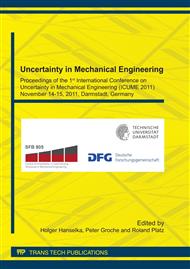p.103
p.115
p.125
p.133
p.145
p.161
p.177
p.187
p.197
Effect of Suspension Parameter Uncertainty on the Dynamic Behaviour of Railway Vehicles
Abstract:
The paper describes a study carried out by Dipartimento di Meccanica Politecnico di Milano, aimed at investigating how uncertainty in railway vehicle suspension components can be treated in the framework of vehicle design and performance assessment in respect to vehicle dynamics. In railway vehicle suspensions, sources of parameter uncertainty may arise from inaccuracy in the modelling of a vehicle component or from a scatter in the behaviour of nominally identical components, on account of the variability implied by the component manufacturing process. The approach proposed in this paper, completely new to the railway field, is to use statistical methods having different complexity (and entailing a proportional computational effort), to analyse the propagation of uncertainty from the parameters input in the vehicle mathematical model to the results of running dynamics, in terms of the assessment quantities used for verification and evaluation of train performances. The problem is treated by numerical means, being the dependency of simulation outputs from the input parameters typically non-linear, and not defined in an analytical form.
Info:
Periodical:
Pages:
177-185
Citation:
Online since:
September 2011
Authors:
Price:
Сopyright:
© 2012 Trans Tech Publications Ltd. All Rights Reserved
Share:
Citation:


